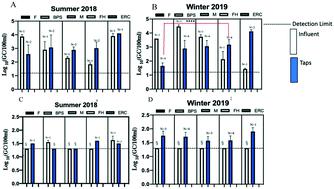当前位置:
X-MOL 学术
›
Environ. Sci.: Water Res. Technol.
›
论文详情
Our official English website, www.x-mol.net, welcomes your
feedback! (Note: you will need to create a separate account there.)
Enumeration and characterization of five pathogenic Legionella species from large research and educational buildings
Environmental Science: Water Research & Technology ( IF 3.5 ) Pub Date : 2020-12-15 , DOI: 10.1039/d0ew00893a Alshae' R. Logan-Jackson 1, 2, 3, 4 , Matthew Flood 2, 3, 4, 5 , Joan B. Rose 1, 2, 3, 4, 5
Environmental Science: Water Research & Technology ( IF 3.5 ) Pub Date : 2020-12-15 , DOI: 10.1039/d0ew00893a Alshae' R. Logan-Jackson 1, 2, 3, 4 , Matthew Flood 2, 3, 4, 5 , Joan B. Rose 1, 2, 3, 4, 5
Affiliation

|
Legionella pneumophila is the species that is most often cultured from the natural environment, while disease-relevant Legionella species, such as Legionella micdadei, Legionella bozemanii, Legionella anisa, and Legionella longbeachae have yet to be extensively explored in premise plumbing systems. This study examined the concentrations of five pathogenic Legionella species (listed previously) in the influent and the taps of five different large buildings (BPS, ERC, F, FH, and M), undertaken during the start of two semesters (late summer/fall (August–September) and early winter/spring (January)). A total of 37 large-volume samples to examine building water quality (influents to the buildings and exposure sites (taps)) were collected and analyzed using droplet digital™ PCR. Legionella spp. (23S rRNA) were present in all water samples during both seasons. The majority (66%) of the exposure sites (bathroom taps) were positive for at least one target Legionella species (listed above). Results showed that pathogenic Legionella species were most often detected during the winter/spring sampling event – the percent positives for any one of the pathogenic Legionella species at the hot-water taps was 80% in building F and 40% in BPS, M, FH, and ERC. Legionella pneumophila and L. longbeachae were found in the highest concentrations (2.0 log10 gene copies (GC)/100 mL) at the hot-water taps in buildings F and ERC, respectively. No strong relationships were found with the physical–chemical parameters. Overall, general Legionella spp. concentrations increased in the winter/spring samples due possibly to lower water usage (lower occupancy and no use of cooling towers, which led to more water stagnation or time in the system).
中文翻译:

大型研究和教学大楼中五个致病军团菌物种的计数和表征
嗜肺军团菌是最经常从自然环境培养的品种,而疾病相关的军团菌的物种,如军团菌micdadei,军团bozemanii,军团菌阿妮萨,和军团菌longbeachae尚未在前提管道系统进行广泛的探讨。这项研究检查了五种致病军团菌的浓度在两个学期开始时(夏季/秋季(8月至9月)后期和冬季初/在五个不同的大型建筑物(BPS,ERC,F,FH和M)的进水口和水龙头中使用了上述物种(之前列出)春天(一月))。收集并检查了37个大体积样品,以检查建筑物的水质(建筑物的进水和暴露部位(水龙头)),并使用Droplet Digital™PCR进行了分析。军团菌属 在两个季节中所有水样中均存在(23S rRNA)。大多数(66%)暴露部位(浴室水龙头)至少对一种目标军团菌属物种呈阳性(上面列出)。结果表明,致病性军团菌在冬季/春季采样事件中最常检测到这些物种-建筑物F中热水龙头上任何一种致病军团菌物种的阳性百分比在F建筑物中为80%,在BPS,M,FH和ERC中为40%。分别在F楼和ERC楼的热水龙头处发现了军团杆菌和长滩乳杆菌的最高浓度(2.0 log 10基因拷贝(GC)/ 100 mL)。没有发现与理化参数有密切关系。总体而言,军团菌属。冬季/春季样品中的浓度增加可能是由于用水量减少(占用率较低且不使用冷却塔,这导致系统中更多的水停滞或时间)。
更新日期:2021-01-12
中文翻译:

大型研究和教学大楼中五个致病军团菌物种的计数和表征
嗜肺军团菌是最经常从自然环境培养的品种,而疾病相关的军团菌的物种,如军团菌micdadei,军团bozemanii,军团菌阿妮萨,和军团菌longbeachae尚未在前提管道系统进行广泛的探讨。这项研究检查了五种致病军团菌的浓度在两个学期开始时(夏季/秋季(8月至9月)后期和冬季初/在五个不同的大型建筑物(BPS,ERC,F,FH和M)的进水口和水龙头中使用了上述物种(之前列出)春天(一月))。收集并检查了37个大体积样品,以检查建筑物的水质(建筑物的进水和暴露部位(水龙头)),并使用Droplet Digital™PCR进行了分析。军团菌属 在两个季节中所有水样中均存在(23S rRNA)。大多数(66%)暴露部位(浴室水龙头)至少对一种目标军团菌属物种呈阳性(上面列出)。结果表明,致病性军团菌在冬季/春季采样事件中最常检测到这些物种-建筑物F中热水龙头上任何一种致病军团菌物种的阳性百分比在F建筑物中为80%,在BPS,M,FH和ERC中为40%。分别在F楼和ERC楼的热水龙头处发现了军团杆菌和长滩乳杆菌的最高浓度(2.0 log 10基因拷贝(GC)/ 100 mL)。没有发现与理化参数有密切关系。总体而言,军团菌属。冬季/春季样品中的浓度增加可能是由于用水量减少(占用率较低且不使用冷却塔,这导致系统中更多的水停滞或时间)。











































 京公网安备 11010802027423号
京公网安备 11010802027423号